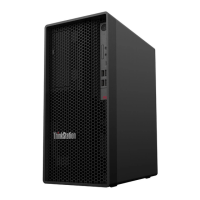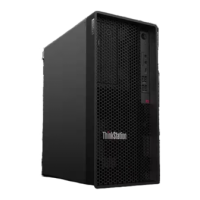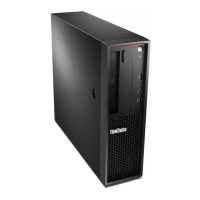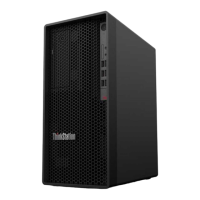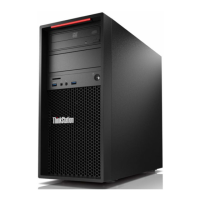Do you have a question about the Lenovo ThinkStation P360 Tower and is the answer not in the manual?
Identifies and describes the front panel components of the computer.
Identifies and describes the rear panel connectors and ports of the computer.
Explains the types and locations of internal storage drives supported by the computer.
Details the physical dimensions, hardware configuration, and key specifications of the computer.
Lists and describes the various USB connectors and their capabilities.
Guides on connecting to wired Ethernet and wireless Wi-Fi networks.
Instructions on connecting monitors or projectors for presentations.
Explains how to use the smart cable clip for cable management.
Introduces the preinstalled Vantage app for system maintenance and support.
Details how to configure power saving settings for the computer.
Describes methods for transferring data, including Bluetooth and media cards.
Guides on connecting Bluetooth devices like keyboards or mice.
Instructions for installing, removing, and using the optical drive.
Steps for installing and removing media cards in the SD-card slot.
Information on acquiring additional hardware accessories and upgrades.
Methods to physically secure the computer using padlocks or cable locks.
Details on enabling or disabling the E-lock feature for cover security.
Guidance on secure login procedures.
Explains setting various passwords (power-on, supervisor, etc.) in UEFI BIOS.
Describes setting a system management password for enhanced security.
Explains certificate-based authentication for secure UEFI BIOS management.
Discusses software-based security measures like firewalls.
How to use Windows Defender Firewall for system protection.
Information on Computrace Agent for IT asset management and theft recovery.
Covers BIOS-level security features for system protection.
Procedures for securely erasing data from storage drives before disposal.
Explains the cover presence switch for preventing unauthorized access.
Describes Intel BIOS Guard for verifying BIOS integrity and preventing attacks.
Details the Smart USB Protection feature to control data transfer to USB devices.
Provides a basic understanding of UEFI BIOS functionality.
Steps to access the computer's BIOS setup utility.
Explains keyboard shortcuts and navigation within the BIOS menus.
How to change the display language within the UEFI BIOS.
Options for selecting graphic or text mode in UEFI BIOS.
Procedure for setting the system's date and time in BIOS.
How to modify the sequence of devices for booting the computer.
Setting up alerts for hardware configuration changes.
Configuring the computer to power on automatically at a set time.
Using keyboard shortcuts to wake or start the computer.
Controls for enabling or disabling specific USB ports via BIOS.
Adjusts acoustic and thermal performance settings.
Guidance on BIOS configuration for OS installation.
Procedures for updating the UEFI BIOS from the OS or a flash disc.
Steps to recover the system if a BIOS update fails.
Instructions for clearing the CMOS settings to restore BIOS defaults.
Explains Redundant Array of Independent Disks technology and its benefits.
Details the different RAID levels (0, 1, 5, 10) supported by the computer.
Steps to enable RAID in the system BIOS for storage configuration.
Instructions for creating, deleting, and resetting RAID volumes in UEFI.
Information on using Lenovo's diagnostic tools for hardware testing.
How to use the Vantage app for diagnosing computer problems.
Lists Customer Replaceable Units (CRUs) for self-service replacement.
General instructions for removing and replacing CRUs.
Steps to remove and replace the computer's outer cover.
Procedure for removing and replacing the optical drive.
Steps for removing and replacing the front bezel.
Instructions for handling and replacing primary hard disk drives.
Procedure for removing and replacing the 3.5-inch HDD cage.
Steps for removing and replacing PCIe expansion cards.
Procedure for removing and replacing the graphics card fan.
Steps for removing and replacing the graphics card holder.
Instructions for removing and replacing graphics cards.
Procedure for replacing M.2 SSDs and their heat sinks.
Steps for removing and replacing M.2 SSD brackets.
Procedure for removing and replacing the optical drive cage.
Instructions for handling and replacing secondary hard disk drives.
Procedure for accessing and managing front-access storage drives.
Steps for removing and replacing the front cooling fan.
Procedure for removing and replacing the rear cooling fan.
Instructions for removing and replacing the CPU heat sink and fan assembly.
Procedure for removing and replacing the chassis beam.
Steps for installing and replacing memory modules.
Procedure for removing and replacing the power supply unit.
Steps for removing and replacing the coin-cell battery.
Procedure for removing and replacing the E-lock security device.
Lists various resources for troubleshooting and support.
Guidance on accessing Windows built-in help and support.
Instructions on how to contact Lenovo customer support for assistance.
Information on buying extended warranty or support services.
Details product certification and machine types.
Specifies operating and storage conditions (altitude, temperature, humidity).
Legal notices regarding product use, warranties, and intellectual property.
Lists trademarks associated with Lenovo and third-party products.
Identifies and describes the front panel components of the computer.
Identifies and describes the rear panel connectors and ports of the computer.
Explains the types and locations of internal storage drives supported by the computer.
Details the physical dimensions, hardware configuration, and key specifications of the computer.
Lists and describes the various USB connectors and their capabilities.
Guides on connecting to wired Ethernet and wireless Wi-Fi networks.
Instructions on connecting monitors or projectors for presentations.
Explains how to use the smart cable clip for cable management.
Introduces the preinstalled Vantage app for system maintenance and support.
Details how to configure power saving settings for the computer.
Describes methods for transferring data, including Bluetooth and media cards.
Guides on connecting Bluetooth devices like keyboards or mice.
Instructions for installing, removing, and using the optical drive.
Steps for installing and removing media cards in the SD-card slot.
Information on acquiring additional hardware accessories and upgrades.
Methods to physically secure the computer using padlocks or cable locks.
Details on enabling or disabling the E-lock feature for cover security.
Guidance on secure login procedures.
Explains setting various passwords (power-on, supervisor, etc.) in UEFI BIOS.
Describes setting a system management password for enhanced security.
Explains certificate-based authentication for secure UEFI BIOS management.
Discusses software-based security measures like firewalls.
How to use Windows Defender Firewall for system protection.
Information on Computrace Agent for IT asset management and theft recovery.
Covers BIOS-level security features for system protection.
Procedures for securely erasing data from storage drives before disposal.
Explains the cover presence switch for preventing unauthorized access.
Describes Intel BIOS Guard for verifying BIOS integrity and preventing attacks.
Details the Smart USB Protection feature to control data transfer to USB devices.
Provides a basic understanding of UEFI BIOS functionality.
Steps to access the computer's BIOS setup utility.
Explains keyboard shortcuts and navigation within the BIOS menus.
How to change the display language within the UEFI BIOS.
Options for selecting graphic or text mode in UEFI BIOS.
Procedure for setting the system's date and time in BIOS.
How to modify the sequence of devices for booting the computer.
Setting up alerts for hardware configuration changes.
Configuring the computer to power on automatically at a set time.
Using keyboard shortcuts to wake or start the computer.
Controls for enabling or disabling specific USB ports via BIOS.
Adjusts acoustic and thermal performance settings.
Guidance on BIOS configuration for OS installation.
Procedures for updating the UEFI BIOS from the OS or a flash disc.
Steps to recover the system if a BIOS update fails.
Instructions for clearing the CMOS settings to restore BIOS defaults.
Explains Redundant Array of Independent Disks technology and its benefits.
Details the different RAID levels (0, 1, 5, 10) supported by the computer.
Steps to enable RAID in the system BIOS for storage configuration.
Instructions for creating, deleting, and resetting RAID volumes in UEFI.
Information on using Lenovo's diagnostic tools for hardware testing.
How to use the Vantage app for diagnosing computer problems.
Lists Customer Replaceable Units (CRUs) for self-service replacement.
General instructions for removing and replacing CRUs.
Steps to remove and replace the computer's outer cover.
Procedure for removing and replacing the optical drive.
Steps for removing and replacing the front bezel.
Instructions for handling and replacing primary hard disk drives.
Procedure for removing and replacing the 3.5-inch HDD cage.
Steps for removing and replacing PCIe expansion cards.
Procedure for removing and replacing the graphics card fan.
Steps for removing and replacing the graphics card holder.
Instructions for removing and replacing graphics cards.
Procedure for replacing M.2 SSDs and their heat sinks.
Steps for removing and replacing M.2 SSD brackets.
Procedure for removing and replacing the optical drive cage.
Instructions for handling and replacing secondary hard disk drives.
Procedure for accessing and managing front-access storage drives.
Steps for removing and replacing the front cooling fan.
Procedure for removing and replacing the rear cooling fan.
Instructions for removing and replacing the CPU heat sink and fan assembly.
Procedure for removing and replacing the chassis beam.
Steps for installing and replacing memory modules.
Procedure for removing and replacing the power supply unit.
Steps for removing and replacing the coin-cell battery.
Procedure for removing and replacing the E-lock security device.
Lists various resources for troubleshooting and support.
Guidance on accessing Windows built-in help and support.
Instructions on how to contact Lenovo customer support for assistance.
Information on buying extended warranty or support services.
Details product certification and machine types.
Specifies operating and storage conditions (altitude, temperature, humidity).
Legal notices regarding product use, warranties, and intellectual property.
Lists trademarks associated with Lenovo and third-party products.
| Chipset | Intel W680 |
|---|---|
| Processor | Up to 12th Gen Intel Core i9 |
| Operating System | Windows 11 Pro |
| Memory | Up to 128GB DDR5 |
| Graphics | Up to NVIDIA RTX A5000 |
| Ports | USB 3.2 Gen 2, USB-C, HDMI, DisplayPort, audio jacks |
| Power Supply | 500W or 750W (depending on configuration) |
| Dimensions | 170mm x 376mm x 315.4mm (6.7" x 14.8" x 12.4") |
| Expansion Slots | 1x PCIe 5.0 x16, 1x PCIe 3.0 x4 |
